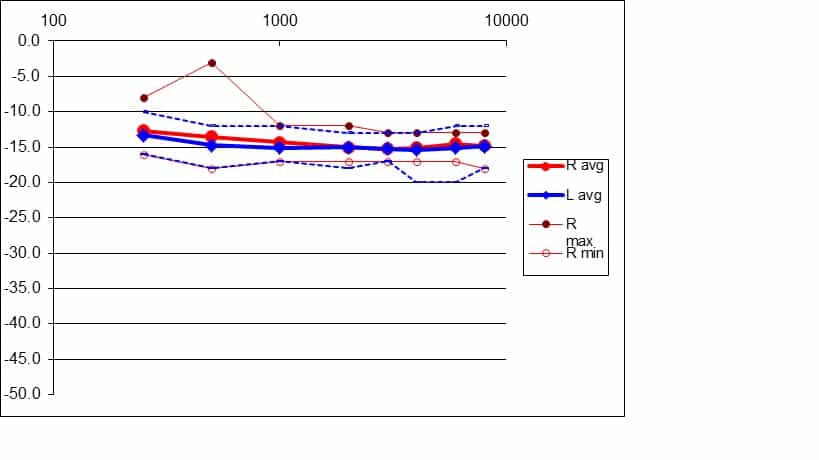There was a recent presentation given at the National Hearing Conservation Association (NHCA) conference last month questioning the integrity of the ER-15 uniform attenuator for musicians. The ER-15 custom made earplug has been available since 1988 and provides a much more uniform attenuation (lessening of sound energy) across the frequency region than other types of hearing protectors that have been designed with industry in mind.
My short response to this presentation is that the data was either measured incorrectly or just outright wrong. I have been fitting the ER-15 earplug (and its cousins, the ER-25 and ER-9) for almost 25 years and the actual musician data and subjective responses are amazing. If a musician loses their pair of ER-15 earplugs, this is an “emergency situation” and I even get calls at home to have them replaced as soon as possible. Subjectively, placing one’s finger over the small diaphragm opening will demonstrate the benefit of the ER-15 earplug. This clinical trick temporarily removes the benefit of the ER-15 and simulates a conventional foam earplug that may be used in industry. The audiologist just needs to say the sound /sssss/ which has high frequency energy starting at 4000 Hz + while the audiologist removes their finger from the diaphragm; immediately the musician smiles and says the right side of the piano keyboard just came back.
But let me now give a longer answer with some data. And I must apologize to my secretary who pulled 50 random musician files (and who now needs to refile them). Fifty files were examined and the real ear measurement data of the actual attenuation of the ER-15 were recorded.
Like hearing aid fittings, verification is the cornerstone of a good fitting. Hearing aid attenuation values with the ER-15 (or any earplug) is just as important, and it needs to be done correctly.
So, let’s start with the correct way to do this. Calibrate the real ear measurement system in the normal fashion and then set the stimulus level to 70 dB SPL. Perform a real ear measurement of the unoccluded ear canal (known as the Real Ear Unaided Response or REUR) and then without removing the probe tube microphone, perform a second real ear measurement of the “aided” response with the ER-15 in place. The difference is the real ear attenuation of the ER-15 for that individual.
Even though modern real ear measurement systems call this an “aided” response, when we are dealing with hearing protectors, we are referring to “negative gain” or attenuation. It is as if the hearing protector was a hearing aid working in reverse- to attenuate sound.
The stimulus level needs to be at least 70 dB SPL because unlike hearing aids the real ear “aided” response with the ER-15 will be a lower number- that is, the ER-15 lessens or attenuates the sound. If I recall my grade 3 math, 70 dB – 15 dB = 55 dB. Values around 45 dB and higher are easily measured by real ear measurement systems, whereas quieter sounds are not. This is because all real ear measurement systems have internal noise and this noise floor can result in a testing artifact. If a level of 50 or 55 dB SPL, which is normal for hearing aid work, was used as the stimulus, minimal attenuation would actually be measured in the higher frequency region, since erroneously we would really only be measuring the internal noise of the real ear measurement machine and not the hearing protector.
In order to improve reliability, all stimuli should be presented from 45 degrees off to the side, and 45 degree above the musician’s head. There is nothing magic about this loudspeaker location- it simply has been studied over the last 30 year and found to be the best location, for a number of reasons.
Like any assessment tool, its strengths and weaknesses have to be known.

Average attenuations for 50 pairs of ER-15 hearing protectors showing the maximum and minimum values
I have included a graph of the 50 ER-15 earplugs- red data is for the right ear and blue, for the left. Standard deviations are all less than 2 dB but in this graph the maximum and minimum data points are shown for all of the test frequencies. Indeed, the ER-15 is a flat or uniform hearing protector. Some musicians have a slight roll-off in the higher frequency regions and others do not. But like any hearing protector, these data are well within the published specifications for the ER-15.
One note is worthy of attention. Whenever there is a probe tube inserted in an ear canal with a hearing protector (or a hearing aid) in place, there may be a small “slit leak” formed between the ear canal wall and the device being assessed. As can be seen in the figure, for some musicians, this has reduced the measured attenuation in the lower frequency region (250 Hz and 500 Hz). This is an artifact of my testing and is a well-known artifact of real ear measurement with any device. In many cases (but not all) I had used a bit of Vasoline around the edges of the probe tube to minimize this. Clearly I wasn’t always successful, but for the most part, this worked well.
In short…. or is it too late,… ER-15 musician hearing protectors are as advertised and they do indeed provide a uniform attenuation for the musician. These data are not routinely published in the literature for the same reason as real ear measurement data is not routinely published. This is part and parcel of a routine clinical audiology assessment and is part of the verification process which any hearing health care professional uses regardless of whether it is for positive gain (hearing aids) or negative gain (hearing protectors).





